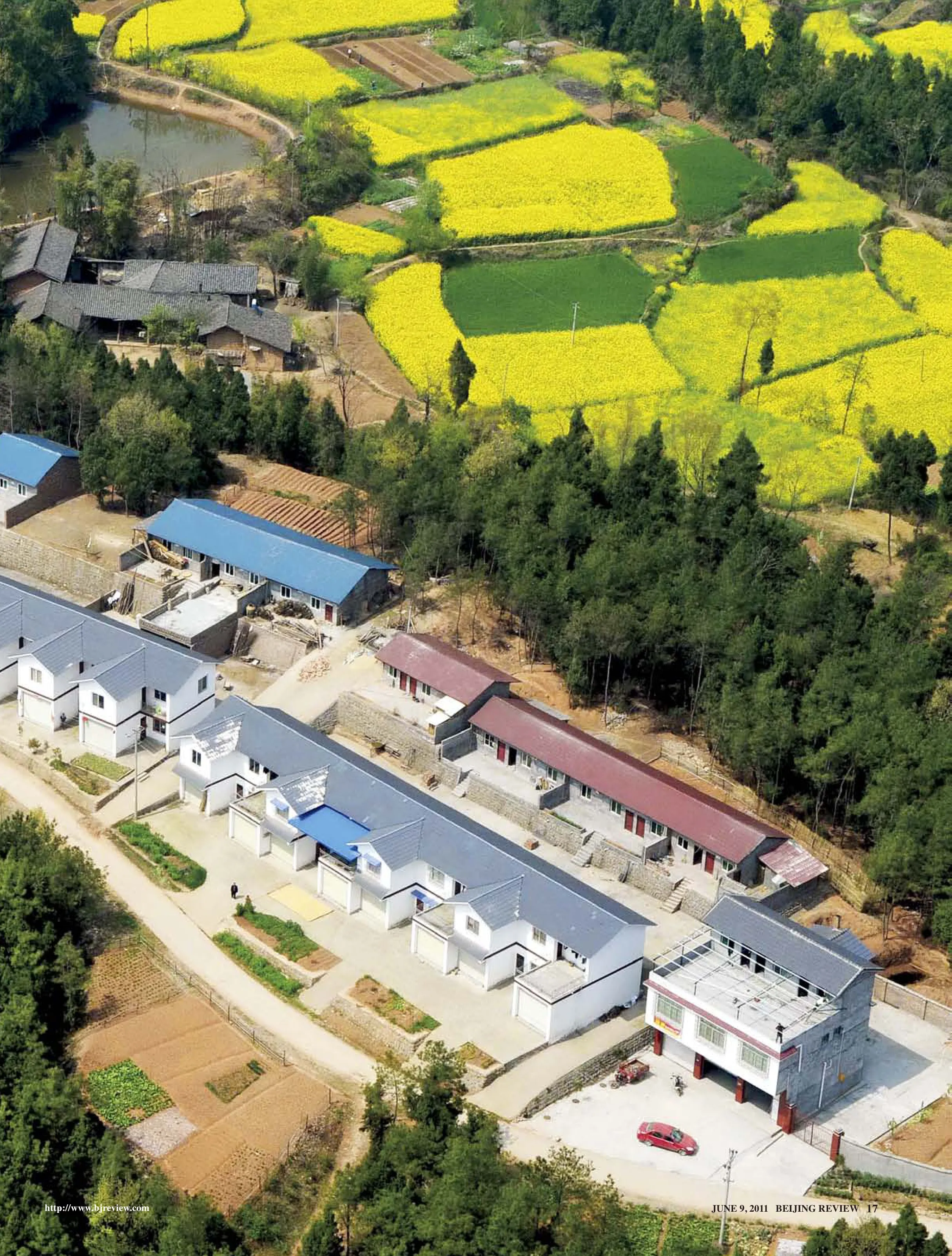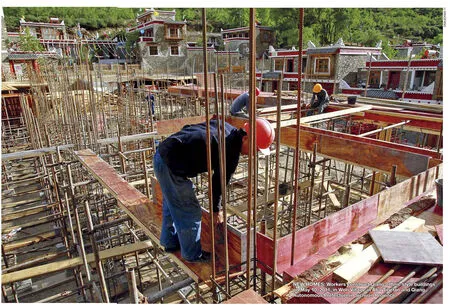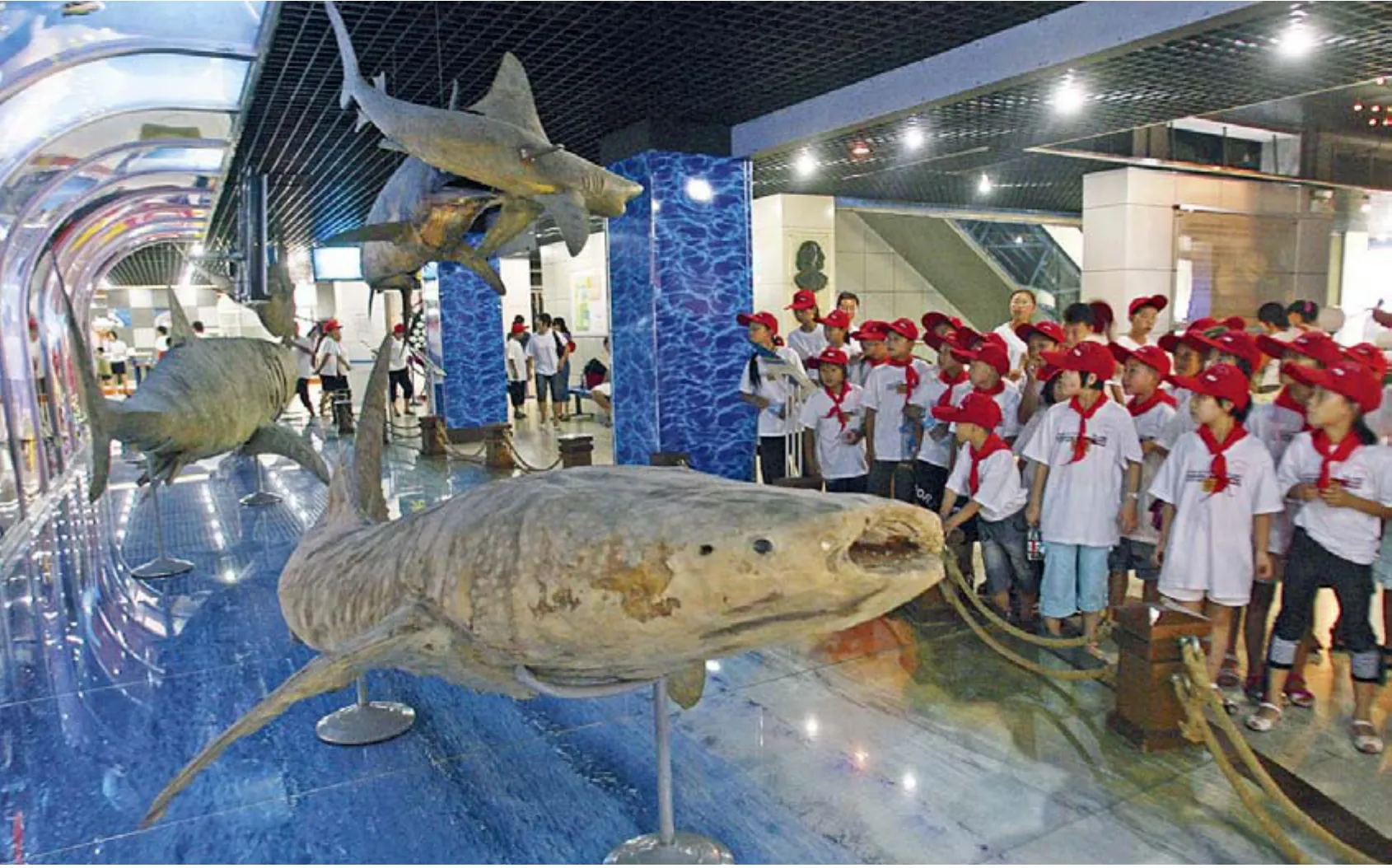THE SICHUAN EXPERIENCE
2011-10-14ByDINGZHITAO
By DING ZHITAO
THE SICHUAN EXPERIENCE
In the quake-ravaged province, the Chinese people have rallied together to help victims rebuild their towns, confidence and lives

By DING ZHITAO
Hiding at the end of a brandnew mountain road, Hongbai Town, deep in the mountainous regions of Sichuan Province, welcomes visitors with its majestic two-story gray-and-white buildings and the smiling faces of its residents. The distinct local dialect fills the air as townspeople sit on bamboo chairs outside a convenience store and go about their daily routines. It is just another tranquil midday in this summer.
A museum serves as a reminder of a less serene afternoon just three years ago when the Earth shook violently, claiming more than 1,000 lives in the town. Only 20 km away from the epicenter of the devastating Wenchuan earthquake of May 12, 2008, Hongbai was hit the hardest in Shifang City. Photos of the disaster and debris from the ruins fill the museum telling of the town’s darkest hours.
These days, villagers in Hongbai are more eager to tell a different story—the story of recovery and reconstruction.
Help from afar
The 8.0-magnitude Wenchuan earthquake that hit Sichuan and neighboring Gansu and Shaanxi provinces claimed 69,277 lives, leaving another 374,176 in need of serious medical attention. To date, more than 18,000 people are missing. In the immediate wake of the disaster, 4.8 million people were left homeless.
On June 11, 2008, the State Council, China’s Cabinet, unveiled a partnership assistance program, requiring 18 provinces and municipalities each to assist the reconstruction of a quake-affected city or county in these areas.
Beijing was one of the first regions to respond to the Central Government’s call. Eight construction companies from Beijing, which had built venues of the 2008 Olympic Games, were some of the first to arrive in Shifang.
“Beijing helped us immensely. Shifang almost became the Beijingers’ second home, the way the workers cared about reconstruction efforts and aiding the locals,”Liu Anrong, owner of a grocery, toldBeijing Review.
In total, Beijing donated 7 billion yuan ($1.08 billion) for reconstruction efforts in Shifang, among which 180 million yuan ($27.78 million) was for Hongbai, which was fattened by the quake.
Over the past three years, the 18 provinces and municipalities dispatched 2,740 officials, more than 310,000 workers and 29,400 professionals to work in the quake zone, said figures from the Sichuan Provincial Government.
Sweet home
The new towns springing up across Sichuan, while true to their original design and architectural style, are modern, featuring the latest in earthquake-resistant building materials.
As of April 2010, kindergartens, schools, daycare centers, community clinics, water systems, sewage disposal plants and garbage treatment facilities had been built in Hongbai in line with level 8 quake resistance specifications. The new town has a current area of 2 square km. Before the quake, it was just 0.75 square km. With new roads and telecommunications networks, Hongbai, once not even marked on most maps, is now known by and connected with the outside world.
A 30-minute ride from Hongbai is Mianzhu City, which now features an architectural style similar to Suzhou, a garden city in east China’s Jiangsu Province. The eastern city is famed for its delicately designed houses, bridges and gardens. Suzhou, along with Hangzhou in Zhejiang Province, has been praised as a paradise on Earth.
Reconstruction workers from Suzhou working in Mianzhu are adamant about their role in rebuilding the city. “We won’t go back home until Mianzhu looks as wonderful as Suzhou” is a proud declaration among many of the aid workers from the east China city. In the past three years, a team of 200 designers and 5,000 workers from 20 construction groups finished 103 projects with a combined investment of 2.8 billion yuan ($432.12 million) in Mianzhu.
In Mianzhu and beyond, aid workers fought the clock to provide a speedy recovery to the region and its people. Their efforts are paying off as local residents boast about the beauty of the houses, the safety of the schools and the state-of-the-art hospitals.
Sustainable growth
The nationwide countrywide partnerships don’t just extend to rebuilding cities and towns. It also includes revitalizing economies from the local to provincial level.
“Besides giving us a completely new, modern town, aid workers from Shandong Province are showing us new economic and social development paths,” Han Guijin, Deputy Director of Reconstruction Project of Beichuan County, toldBeijing Review.
Beichuan was one of the worst areas to bear the brunt of the earthquake. In a mere 90 seconds, thousands of residents in the town perished. Almost every family in the town suffered casualties. The fattened town (See page 22) now functions as a memorial site. A new town for Beichuan survivors, called Yongchang, which means eternal prosperity, now stands 20 km away.
Starting in June 2009, more than 30,000 aid workers from Shandong rolled up their sleeves, devoted to the 64 projects in Yongchang. A total of 4.6 billion yuan ($709.92 million) from Shandong poured into the new town, and in September 2010, a 5-square-km town, expected to be home to 35,000 people, was ready for Beichuan residents.

In addition, 24 enterprises, with a total investment of 1.6 billion yuan ($246.94 million) from Shandong, started operating in the 1.4-square-km Beichuan-Shandong Industrial Park. More than 1,000 manufacturing jobs were initially created. An agricultural park with a total investment of 180 million yuan ($27.73 million) is under construction and will provide more than 10,000 jobs. Experts from Shouguang in Shandong, one of China’s largest vegetable trading hubs, are helping build a vegetable base in the park.
The situation in nearby new towns is also promising. Newly fnished Jiangsu Industrial Park in Mianzhu and Wuxi Industrial Park in the city’s Hanwang Town cover around 10 square km. More than 20 hi-tech enterprises have settled in and are looking for employees. They have the ambition to build themselves into provincial-level industrial parks each with an annual output value of 50 billion yuan ($7.72 billion) in fve years.
Not far away in Hanwang, the traditional New Year’s painting industry fourishes after taking advantage of the partnership. Suzhou spent more than 30 million yuan ($4.62 million) and established a New Year’s painting base in Nianhua Village, a new village combining two former villages. Now more than 90 percent of the villagers make a living on making New Year’s paintings, as well as related businesses in the process. Jiangsu has also helped with sales of the paintings.
“We have a new house, and a new life,”Wei Daxiang, a 62-year-old villager from Nianhua Village, toldBeijing Review. Her two sons and daughters-in-law are either employed in the Jiangsu Industrial Park or engaged in painting-related businesses.
Tradition reawakening
Mianzhu is one of the four famous manufacturers of New Year’s paintings in China, along with Yangliuqing in Tianjin, Taohuawu in Jiangsu and Weifang in Shandong. It features bright colors and intricate hand painting, a style dating back to the Song Dynasty (960-1279) and thrived in the Qing Dynasty (1644-1911) but fell to the wayside in recent decades. Young people have been reluctant to learn the skills required to master the handicraft. Since the reconstruction began, the art form, which is protected as an intangible cultural heritage, has been saved from the brink of extinction.
Thirty-year-old Chen Gang is one of the inheritors of the Mianzhu New Year’s painting craft. He is learning from his 92-year-old grandfather and will teach his 4-year-old son. More than 100,000 yuan ($15,400) can be made annually from the business, Chen toldBeijing Review.
Many other counties and villages once severely damaged in the quake are also finding their own development path through cultural business. Wenchuan County, 80 km northwest of Chengdu, capital of Sichuan, was the epicenter of the quake. During the reconstruction, two of its towns, Yingxiu and Shuimo, have developed a tourism industry themed on Qiang and Tibetan ethnic cultures with help from south China’s Guangdong Province. The efforts have helped preserve minority culture and traditions.
In Shuimo, the Aba Teachers’ College, the only basic education teacher training institution in Aba Tibetan and Qiang Autonomous Prefecture, Sichuan Province, is slated to open in September 2011, enrolling thousands of students and having hundreds of teachers. “They will boost consumption and promote the local culture,” said Deputy Town Mayor Wen Yonggang.
“Setting up an institution of higher learning in a town is unprecedented in China, as these institutions previously were all located in cities,” he said. “This would not have been possible without the help from Guangdong.”
Green future
Ecological preservation was considered during the planning phases of every project throughout Sichuan. The reconstruction efforts were widely recognized as a oncein-a-lifetime opportunity to achieve a better economic restructuring and shift to a sustainable and environment-friendly development path.
In Shuimo, the environment shows obvious signs of improvement now that polluting industries have all but vacated the area. Only two enterprises remain, and both are non-polluting, hi-tech ones, said Wen.
In the town, the air is brisk and clear; a narrow crystal stream flows along the main business street. On the mountains surrounding the town, traces of bare earth left by landslides triggered by the earthquake are turning a greenish gray.
“They were yellow before. The color change is a sign of forestation,” Guo Shanying, a Wenchuan County offcial, toldBeijing Review.

(Left) SWEAT SOAKING: Workers from Luoyang, Henan Province, construct temporary buildings in quake-hit regions in Sichuan Province, on May 28, 2008

ZhANG XIAOLI
Bailu Town (See page 26) near Pengzhou City has combined its connection with French culture and its lush natural environment to develop tourism. Southeast China’s Fujian Province has been providing assistance to Pengzhou through the partnership assistance program.
In Yongchang, the application of energysaving technology in the reconstruction process has yielded a low-carbon town. Ground source heat pumps are used in hospitals and hotels to save energy. The main street, plaza and business street are equipped with high-power LED lights. Through the use of clean energy and recycled energy, maintenance costs have been greatly reduced.
Mental recovery
Recovery in people’s hearts and minds is as important a part of reconstruction efforts, said Guo. “New houses are useless if one has no will to live,” he said.
With painstaking efforts from local governments and provincial assistance, wounds for many have healed with time. So far, not a single case of suicide among earthquake survivors suffering from the psychological backlash of the disaster has been reported, said Guo.
The situation of Beichuan, as opposed to other areas of Sichuan, was more complicated, as the people there suffered more severe mental problems. Ren Xuemei, Director of Psychological Medical Service Center of Beichuan County, toldBeijing Review, in the past three years, her center followed up and provided support to all residents in the town showing symptoms of insomnia, anxiety or depression, all early signs of post-traumatic stress disorder.
“The workload was overwhelming at the beginning,” said Ren. “The center had six medical staff. Beichuan had around 230,000 residents.”
Soon assistance poured in. Qingdao University in coastal Shandong provided psychological assistance for students and teachers in Beichuan. It also helped build standard mental health centers and trained staffers. Summer camps for students and teachers from Beichuan were organized in Qingdao and other cities in Shandong.
So far, 5,167 mental health service centers have been established covering all villages in the quake zone. About 125,000 people have received psychological counseling, according to statistics from the Sichuan Provincial Health Department.
In the meantime, the government encouraged survivors who lost a spouse to consider remarrying. Families that lost children were also encouraged to have another child (See page 27). Parents who lost children are regarded as the most depressed group following the quake.
In the year after the quake, more than 1,000 remarried couples started new lives. By the end of March this year, 3,761 women who lost children to the quake had given birth to new babies, said figures from the Sichuan Provincial Government. They have received financial, technical and mental assistance from both local governments and the assistance partners.
Partnership experience
“Sichuan’s reconstruction is a miracle,”said Huang Xinchu, head of the Publicity Department of Sichuan Provincial Committee of the Communist Party of China.
As of May, more than 98 percent of the planned 29,692 post-quake reconstruction projects funded and built by the 18 provinces and municipalities had been finished. By September 2011, the remaining projects will wrap up, according to the latest fgures from Sichuan Provincial Government.
The partners, Huang said, have done some unprecedented in the history of reconstruction projects. “What they have accumulated during the process could become known as the Sichuan experience,” he said.
Partnership assistance is a special arrangement and an innovative creation of the Chinese Government, said Wei Hong, Deputy Governor of Sichuan Province. Since the People’s Republic of China was founded in 1949, similar programs have been applied to Tibet and Xinjiang autonomous regions throughout the decades.
Besides the partnership assistance, Sichuan also received help from Hong Kong, Macao and Taiwan, as well as foreign governments, enterprises, NGOs and individuals.
When the partnership assistance program concludes in September, a longterm cooperation mechanism will be established between assisting provinces and municipalities and quake-affected cities and counties in Sichuan, Wei said.“The partnership assistance will evolve into partnership cooperation,” he said.
His words were echoed by Han Guijin from Beichuan. The industrial and agricultural parks in his new town can help outsource Shandong’s labor-intensive industries and boost huge market potential. “In this way, Beichuan is returning the favor and helping Shandong’s industrial restructuring,” Han said.
